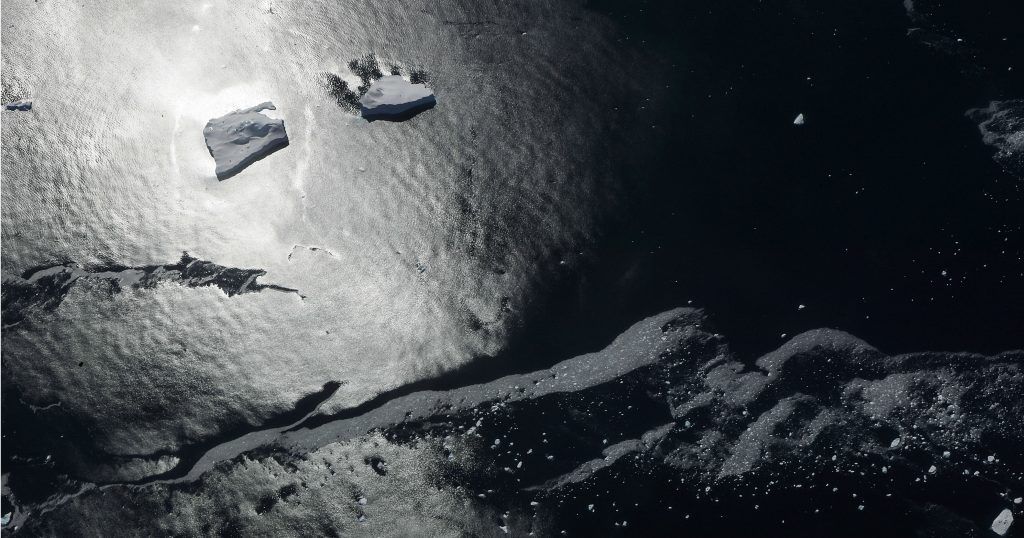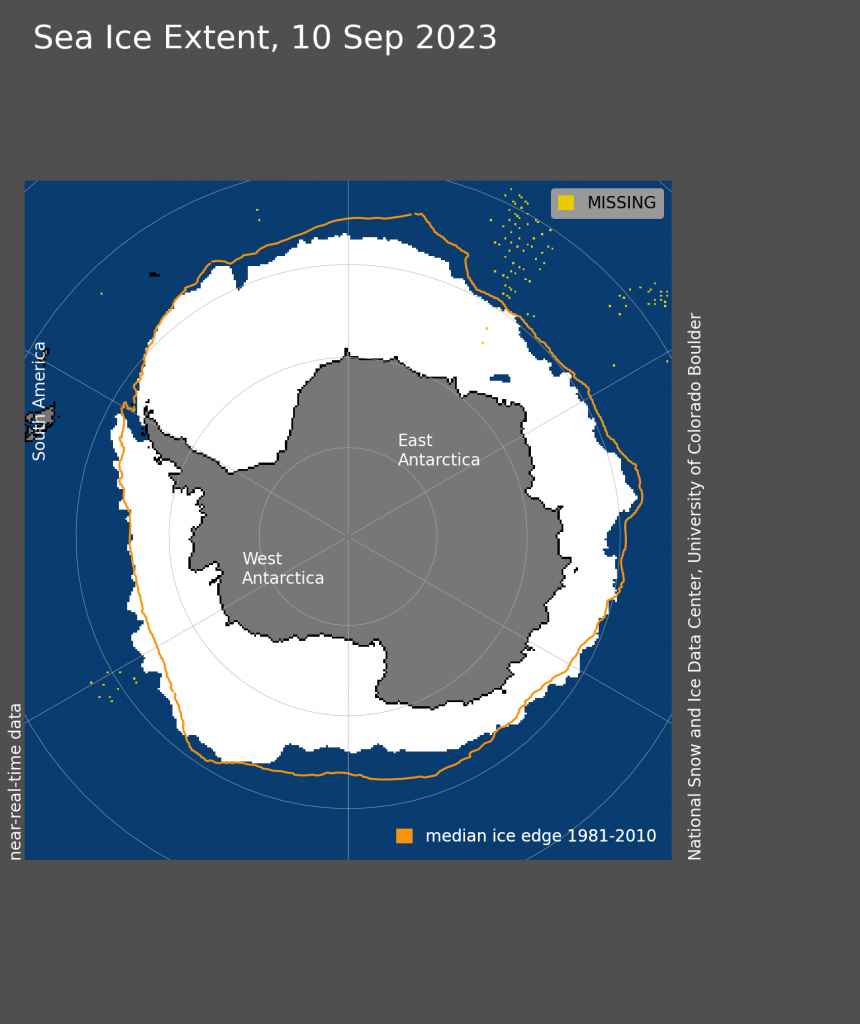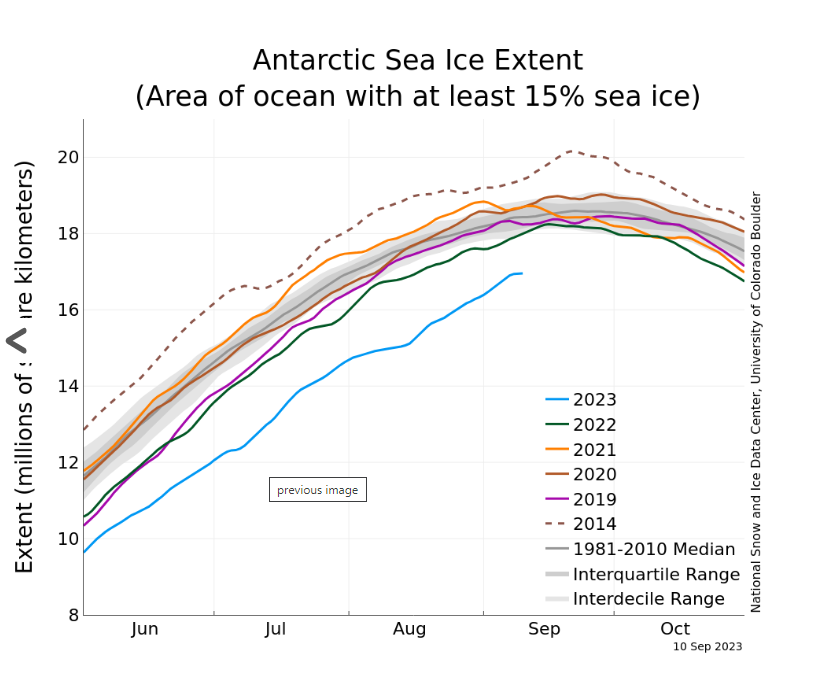Antarctic 2023 sea ice maximum hits record low since satellite data began

(Mario Tama/Getty Images)
Maximum Antarctic sea ice extent hit a likely all-time low on September 10, setting a historic record since satellite data collection began in 1979, the U.S. National Snow and Ice Data Center (NSIDC) said.
On that day, the continent’s annual maximum extent was measured only 16.96 million square kilometres, one million square kilometers below the previous record low set in 1986.
“Nothing really prepared us for this year,” Walt Meier, a senior research scientist at NSIDC, said in a phone interview.
“This is a really extreme year for the Antarctic and something that we’ve not seen before in our satellite data.”
In comparison with the Arctic, where rapid environmental changes and sea ice loss has been heavily recorded, especially in the last two decades, Antarctic sea ice extent has been relatively stable, Meier said.
In 2016, the first signs of a downward trend in Antarctica emerged, marked by occasional record-low minimum ice extents. However, this trend was not continuous and characterized by significant fluctuations, making the preliminary data released this week all the more surprising, Meier said.
“I would say we were shocked,” he said. “The changes in the Arctic have really been capturing attention over the last 20 years and in a sense, the Antarctic was not playing along.
“We expect a lot of variability from the Antarctic, but I don’t think anyone really expected it to be this extreme.”
Ice distributions around contenant
The distribution of ice around the continent was different.
The NSIDC described the ice extent north of Queen Maud Land and west of the Antarctica Peninsula as “markedly below average.” It was also low near the Ross Sea and the Indian Ocean, the centre said.
Meanwhile, ice extent off the Amundsen Sea was above average.

“Since August 2016, the Antarctic sea ice extent trend took a sharp downturn across nearly all months,” the NSIDC said.
“This more recent excursion, beginning in May of 2023, and the general persistence of low sea ice extent near Antarctica since 2016, is now thought to be linked to warming in the uppermost ocean layer caused by lateral and upward mixing of warmer water.”
The NSIDC said that with ocean warming across the planet this could increasing mix with the Southern Ocean’s polar layer.
“The Southern Ocean and its sea ice is an important component of Earth’s energy balance, reflecting sunlight back into space, and supporting a rich ice-edge ecosystem,” the centre said.
Polar layers are sections of the ocean that have unique properties because of their location in Antarctica and in the Arctic. Besides things like low temperatures, they can also include high salt content because of their proximity to sea ice and have unique ecosystem functions in polar regions.

The NSIDC said warm waters mixing with the polar layers could have far-reaching environmental impacts going ahead, not only on Antarctic species that rely on sea ice for food and breeding, but also on things like erosion.
“If dramatically lower sea ice extent continues to the 2024 summer minimum and beyond, much more of the Antarctic coastline will be exposed to ocean waves and marine climate,” the center said.
“This may lead to two opposing impacts: erosion of more perennial coastal ice and ice shelves, destabilizing the ice sheet; or increased accumulation near the coast, offsetting in part the threat of rising sea level.”
‘No place immune to climate change’
The NSIDC said the data released this week is preliminary, and further analysis and possible causes behind this year’s ice season will be released at the beginning of October.
“It’s a complex picture in Antarctica because ocean currents and the winds that encircle the continent that play a big role beyond just the temperature,” Meier said.
“But if Antarctica is changing, it’s another stark indication that there’s no place immune to climate change, not even the farthest south portions of the earth.”
Comments, tips or story ideas? Contact Eilís at eilis.quinn(at)cbc.ca
Related stories from around the North:
Canada: Hot and dry July saw temperature records topple in the Yukon, CBC News
Greenland: Alarming, above-average ice loss in Greenland due to rising temperatures, Eye on the Arctic
Norway: Polar heat record. July average above 10°C, The Independent Barents Observer
Sweden: High risk of wildfires in many parts of Sweden, including North, Radio Sweden
United States: Bursting ice dam in Alaska highlights risks of glacial flooding around the globe, The Associated Press




The Antarctic has set been setting record high ice conditions for decades. It is just returning to normal range now. Alarmists spreading disinformation, is all.